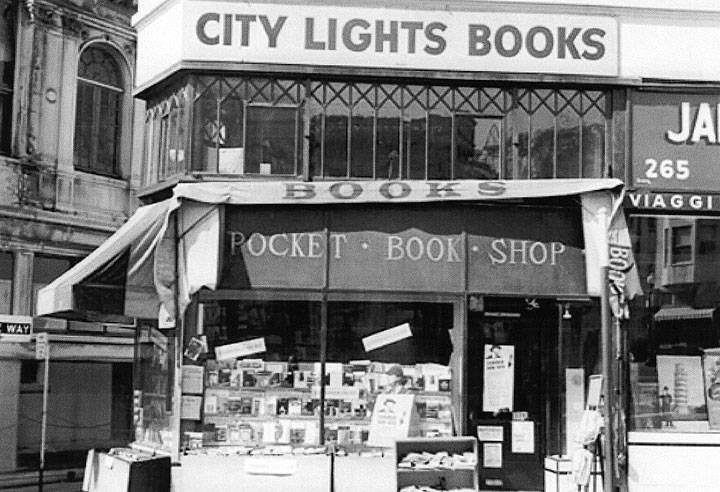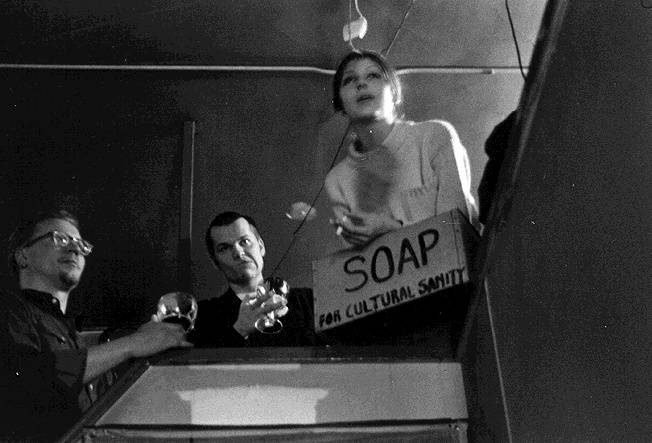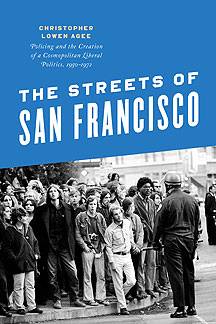The Emergence of the North Beach Beat Scene: Difference between revisions
No edit summary |
No edit summary |
||
| Line 38: | Line 38: | ||
<hr> | <hr> | ||
[[Image:Streets-of-sf cover 978-0-226-12228.jpg|left]] Reprinted with permission from ''The Streets of San Francisco: Policing and the Creation of a Cosmopolitan Liberal Politics, 1950-1972'' by Christopher Lowen Agee, published by the University of Chicago Press. © 2014 by The University of Chicago. All rights reserved. | [[Image:Streets-of-sf cover 978-0-226-12228.jpg|left]] Reprinted with permission from [http://press.uchicago.edu/ucp/books/book/chicago/S/bo17607412.html ''The Streets of San Francisco: Policing and the Creation of a Cosmopolitan Liberal Politics, 1950-1972''] by Christopher Lowen Agee, published by the University of Chicago Press. © 2014 by The University of Chicago. All rights reserved. | ||
[[category:Beats]] [[category:North Beach]] [[category:1950s]] | [[category:Beats]] [[category:North Beach]] [[category:1950s]] | ||
Revision as of 16:47, 13 August 2014
Historical Essay
By Christopher Lowen Agee
A literary meeting-place since 1953, and the first all-paperback bookstore in the U.S., legendary home of the beatniks, publisher of Allen Ginsberg's HOWL, owned by Lawrence Ferlinghetti and Nancy Peters.
Photo: City Lights Bookstore
Tucked between Telegraph Hill and Russian Hill, the financial district and the bay, San Francisco’s North Beach carried deep immigrant, bohemian, and nightlife traditions. The neighborhood bordered the old, well-known Chinatown and Barbary Coast entertainment areas. It had long supported its own assortment of bars, cafes, and restaurants, and the area had a reputation for permissiveness. North Beach was the most densely peopled neighbor- hood of the city and housed an ethnically diverse population that included significant numbers of Irish-, Chinese-, Basque-, and Mexican-Americans. Italian-Americans, however, had held cultural sway over the neighborhood since the turn of the twentieth century. Some Italian-Americans had cultivated the neighborhood’s laissez-faire image by making homemade wine during Prohibition and establishing a small-scale sex-entertainment industry after Prohibition ended.8
North Beach’s tolerant bar and cafe scene, ethnic heterogeneity, and physical isolation from the rest of the city, combined with the area’s low rents, attracted artists to the neighborhood’s southern edge at the end of the nineteenth century. Its bohemian scene flourished through World War II around poets such as Kenneth Rexroth, Philip Lamantia, and William Everson. The postwar growth of the California School of Fine Arts (renamed the San Francisco Art Institute in 1960) on Russian Hill, along with the migration to North Beach of a group of poets trained at the University of California, Berkeley (including Robert Duncan, Jack Spicer, and Robin Blaser), injected vitality into the area’s creative circles during the early 1950s. A new beat movement began coalescing in 1953 and 1954 when writers and poets such as Kerouac, Ginsberg, and Gary Snyder arrived on North Beach’s already thriving literary scene.(9)
Many beat artists felt that the North Beach community supported their creative work and bohemian lifestyle. David Meltzer, a beat poet, later explained that during the mid-1950s:
North Beach . . . was a much more of a European atmosphere, because primarily most of the real estate was managed by Italians and often first-generation Italians, so there was more than one language spoken. And the Italians never felt uncomfortable with the idea of somebody being an artist or a poet. They thought it was a legitimate job—the same as being a plumber. And in fact they had a high regard for this. So rents were low and the atmosphere was conducive to productive work.(10)
The beats living and working in North Beach also socialized in the neighborhood. The commercial hub of the district’s bohemia shifted north during the postwar period, away from the city’s expanding financial district and deeper into the Italian-American neighborhood. In 1949 Henri Lenoir started this migration by opening Vesuvio Café on Columbus Avenue, just south of Broadway Street, and in 1953 Lawrence Ferlinghetti and Peter Martin launched City Lights Pocket Book Shop (renamed City Lights Bookstore a year later) next door to Lenoir’s bar. That same year Knute Stiles and Leo Krikorian helped push bohemia’s commercial hub still farther into residential North Beach by opening The Place, a bar and art gallery, on upper Grant Avenue. The oldest street in San Francisco, Grant Avenue terminated with a narrow, four-block commercial corridor crowded with bars, galleries, art shops, bookstores, Chinese dressmaking factories, and Italian bakeries. Two popular establishments at the corner of Grant Avenue and Green Street—the Co-Existence Bagel Shop and the Coffee Gallery, a dilapidated bar and art space—made that intersection the symbolic epicenter of the neighborhood’s burgeoning beat scene.(11)
The Place hosting Linda Lovely and her soapbox around 1959.
Photo: C.R. Snyder
These beat commercial establishments were launched during a period when the North Beach’s Italian-American merchants and longtime residents were locked in a fight over neighborhood development. Managerial growth advocates argued that they could serve North Beach’s interests by integrating the neighborhood into the city’s mainstream tourist and entertainment economy. North Beach businesspeople encouraged this agenda through the Chinatown–North Beach Development Committee. Residents who did not own businesses, by contrast, regarded these plans as a threat to the neighborhood’s small-scale, family-oriented arrangement. These locals successfully blocked efforts to construct neighborhood parking garages and apartment towers.(12)
Initially, neither side in this debate over development and the residents’ interests could come to a clear consensus on whether the beats represented a boon or danger to its respective neighborhood vision. Older North Beach entrepreneurs often viewed the new beat commercial establishments as invasive competition, while neighborhood consumers appeared appreciative of some of the bohemian businesses. Krikorian, owner of The Place, experienced this divided reception. On the one hand, a neighboring business owner reported to police that Krikorian’s bohemian bar bootlegged hard liquor. This was an accurate accusation, but Krikorian later defended the practice, saying that “the Italians in the neighborhood, not the beats,” purchased this alcohol.(13) As the 1950s continued, even traditional business and property owners learned to appreciate beat consumers and renters as sources of profit. Indeed, the beat scene attracted an influx of young white professionals into the neighborhood, and rents rocketed upward by 92 percent during the 1950s in the northern, central, and eastern sections of the neighborhood.(14)
Thus there was no broad-based neighborhood antipathy toward the beats when, in the summer of 1957, a small group of culturally conservative North Beach residents demanded a crackdown. The protesters submitted a petition to city leaders complaining that when beats roiled the night air with their fights, obscenities, singing, and musical instruments, “regular policemen” did “nothing to stop this disturbance.” A “great many of the maladjusted and anti-social individuals [sic] of our city,” the appeal continued, “have learned that they can come to this small area and demonstrate their contempt for law and order.”(15) Police countered that community indifference enabled the beat scene to grow. In September 1959, for instance, Charles de Caro, a sixty-six-year-old Italian-American butcher, enraged Patrolman Joseph Galik when he refused to help the officer arrest a beat book salesperson. Absurdly, Galik took de Caro in on a posse comitatus charge, invoking a code that had not been used in San Francisco since the nineteenth century. One North Beach booster who objected to the beats’ presence had to admit that the scene flourished along upper Grant Avenue “because the people of this community don’t give a damn.”(16)
Reprinted with permission from The Streets of San Francisco: Policing and the Creation of a Cosmopolitan Liberal Politics, 1950-1972 by Christopher Lowen Agee, published by the University of Chicago Press. © 2014 by The University of Chicago. All rights reserved.



